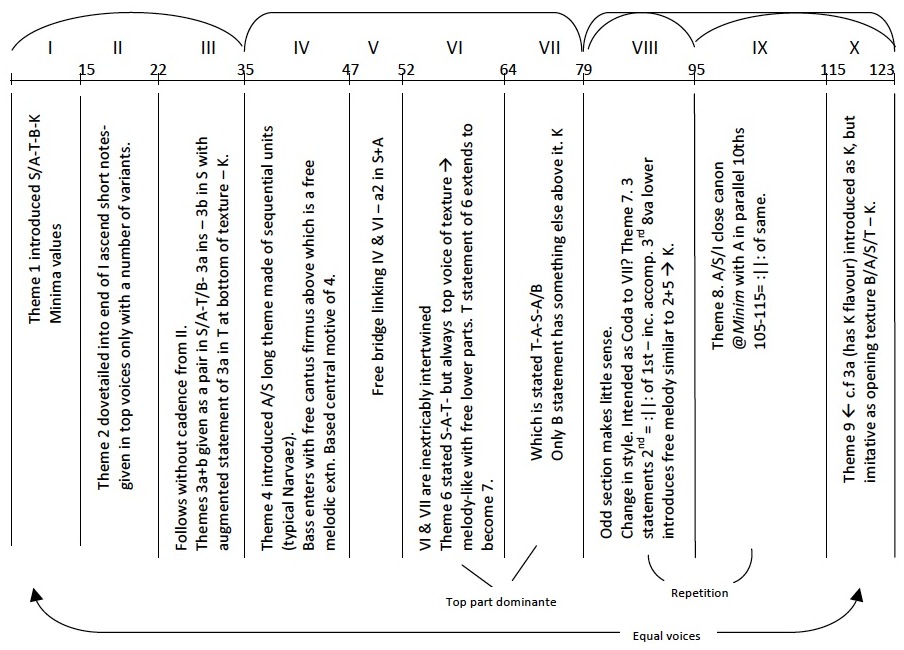Luis de Narváez
Fantasía [01] del primer tono por gesolreut
Los seis libros del Delphin (1538), fol. 1
na001
| Source title | En la quarta en vazio es ta la claue de fefaut. En la tercera en el tercer traste esta la calue de cesolfaut |
|---|---|
| Title in contents | El primer Tono por gesolreut. |
| Text incipit |

Music
Category abstract
Genre fantasia
Fantasia type Par ImP
Mode 1
Voices 4
Length (compases) 123
Vihuela
Tuning G
Courses 6
Final VI/0
Highest I/8
Lowest VI/0
Difficulty not specified
Tempo fast
Song Text
Language
Vocal notation
Commentary
Polythematic imitative fantasía. There is considerable variety in the contrapuntal procedures occurring in the piece. Pujol’s claim that the “cantus firmus” (= theme 1) is of “popular flavour” is clearly inaccurate. Although mainly an original composition, Robinson shows two passages that suggest there might be some level of parody of a fantasia by Alberto da Ripa (Robinson 2014-1, 80-82).
A very tightly knitted continuous work of 123 compases, divisible into ten sections on the basis of musical ideas. The ideas flow very rapidly, and are dovetailed into one another in a way which gives on-going motet like quality as well as drawing little attention to the newly introduced ideas.
The writing is extremely condensed. Cadences do not function as definite points of repose or to sectionalize de work. My sections are artificial in real terms of the sound. Sectional repetition occurs between 79 and 115. Interval of a third is important cohesive device. (Dotted Minim Crotchet Rhythm too)
Beneath measures 115-117 is printed: Nocta: ut re mi fa, signaling the presentation from that point of a final imitative theme. There may be more to this than is presently understood.
Narváez’s fantasia was reprinted by Phalèse and Venegas de Henestrosa:
• Phalèse, Des chansons reduictz en Tablature, fol. c2 (Brown 1546-18, no 9).
• Venegas de Henestrosa, Libro de cifra nueva, fol. 34 (cf. Brown 1557-02, no 56), edited Anglés, pp. 78-80, Fantasia II, also incorporateding material from Mudarra, Fantasia 15 (Mu025).
Comparing the original 1538 Narváez fantasia with the 1546 reprint, Robinson observes that the Narváez original is “identical to Phalèse 1546 except that that latter bars in 4 minims and adds a 1 at 15/1; 25/1 - a4 instead of a3; 79 - minim 4 quavers instead of 3 crotchets 2 quavers (as in bar 9)”.
Regarding the possibly parody, Robinson draws attention to 2 passages in Fantasia 20 by Albert de Rippe (in the Vaccaro edition), from his Quart livre de tabulature de luth, fol. 2 (Brown 1553-09, no 1). The Rippe and Narváez versions of this fantasia are edited together by Robinson in French tablature (Robinson 2014-1, 80-85). The two loosely corresponding passages, according to Robinson (p. 73) are:
Rippe Narváez
1-3 1-5
96-100 106-114
Robinson comments on the Rippe version: “This supplement ends with the fourth part in the series of complete fantasies of Alberto da Ripa/Albert de Rippe, reproducing the remaining two of five fantasies from Quart Livre de Tabulature de Leut (Paris, Le Roy and Ballard, 1553), no 20-21, neither recorded as far as I know. Robinson points out that Narváez must have seen Ripa’s work fifteen years before the earliest print of it in 1553.

Editions
Literature
Recordings
smith03 Narváez, Los seys libros del Delphin Hopkinson Smith solo Narváez
rivera02 El Delfín de Música Juan Carlos Rivera, Marta Almajano solo vihuela song Narváez
wallace05 Delphín Frank Wallace solo Milán Fuenllana Narváez Mudarra Daza
maier01 The Art of Vihuela Ralph Maier solo Milán Narváez Mudarra Valderrábano Fuenllana Daza
marquez01 Luys de Narváez. Música del Delphin Pablo Márquez solo Narváez
diaz01 Narváez, Los libros del Delphin Xavier Díaz-Latorre solo Narváez
cherici01 El Siglo de Oro: Obras para vihuela 1 Paolo Cherici solo Milán Narváez